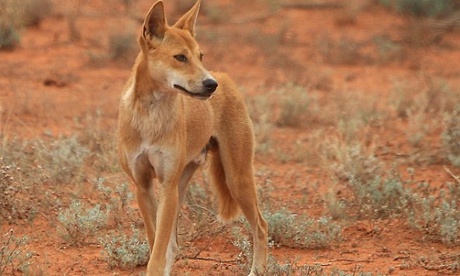Australia’s lengthy “dingo fence” should be altered to allow dingoes into a national park to test whether they can help reverse the precipitous decline of native wildlife, a group of conservation experts has recommended.
The bold experiment would involve remodelling the dingo-proof fence that stretches from eastern Queensland to the South Australian coastline. At more than 5,500km long, the barrier, originally constructed in the 1880s to keep out rabbits, is the longest fence in the world.
Altering the fence’s boundary would enable dingoes to enter the Sturt national park in New South Wales, allowing scientists to assess whether dingoes, long reviled by many people as dangerous to livestock and even humans, could in fact act as saviours for threatened native animals.
Dingoes are known to prey upon kangaroos, emus and feral goats and it’s thought they also deter foxes and feral cats – the two introduced predators blamed for causing massive declines in animals such as bilbies, bandicoots and bettongs across Australia.
But while dingoes were once present across Australia, the combination of the dingo-proof fence and culling of the animals to stop them attacking livestock means they are now not found in large areas of NSW, Victoria and South Australia.
A paper published in Restoration Ecology by Australian ecologists suggests the reintroduction of dingoes could prove beneficial to native wildlife.
“Predation by foxes and feral cats is the key driver of extinctions, so we need to change what we’ve previously done and look at if the dingo can help,” said Dr Thomas Newsome of the University of Sydney, the report’s lead author.
“The dingo fence provides a unique opportunity – if we rebuild it on its eastern and southern sides we can monitor the recolonisation of the area by dingoes while minimising the impact upon graziers.
“At the moment, we know what happens when dingoes are taken out of an environment, but we don’t know what happens when we put them back in. If the theories hold true, we’d expect the dingoes to have positive effect on the ecosystem.”
Newsome said previous studies have suggested that small mammals, reptiles and birds have all benefited from the presence of dingoes. It’s thought they could, in the right circumstances, even aid farmers by preying upon kangaroos, which compete with livestock such as sheep for pastoral land.
“There is a lot of evidence that dingoes have positive effects, we just need to find ways we can coexist with them,” Newsome said. “It’s harder to sell the positives of dingoes if people don’t know about these benefits.”
Australia’s wildlife is suffering an extinction crisis, particularly among its mammals. A total of 29 endemic mammals have become extinct since European arrival. This represents 10% of all original mammal fauna in Australia, the highest rate of extinctions anywhere in the world over the past 200 years.
Clearing of habitat for agriculture and other development is partially to blame, although scientists have identified feral cats and foxes as the primary cause of the decline.
The Australian government is currently working on a new poisoned bait, known as Curiosity, to help make a dent in the estimated 20m feral cats in Australia. A new threatened species hub has also been established with the University of Queensland.
But ecologists are increasingly looking at examples of “rewilding” from overseas as a way of restoring the fortunes of Australia’s unique wildlife.
Rewilding involves the reintroduction of top predators to help restore a better balance to the ecosystem. Numbers of wolves, lynx and bears are rising in Europe, while the introduction of wolves to Yellowstone national park in the US has been credited for multiple benefits to the landscape.
The Victorian government is considering a trial of released Tasmanian devils to improve native wildlife in the Wilsons Promontory national park.
“There’s a growing interest in apex predators as a restoration tool,” Newsome said. “We need to use science as our guide to validly work out the role of these species and whether they can save Australia’s degraded landscapes.”
The dingo trial, if permitted, would last up to 10 years. A control site where dingoes haven’t been reintroduced would also be studied, to compare the prospects of various species.
The NSW government and the federal government were both contacted for their responses to the proposal.











